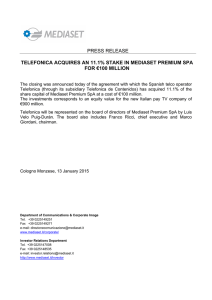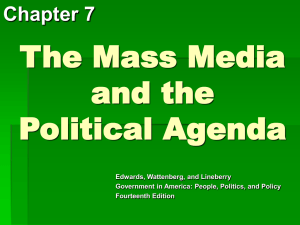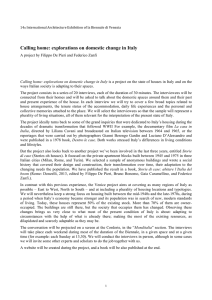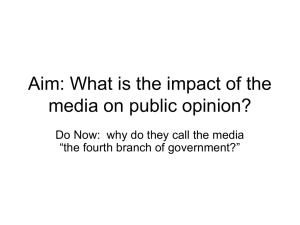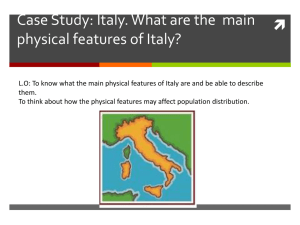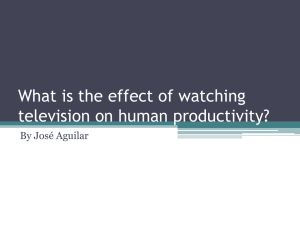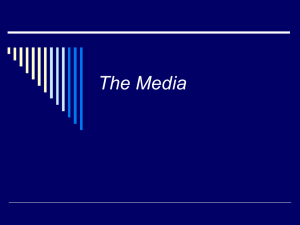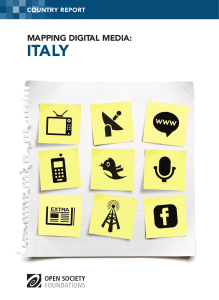Media Industry - GSI ITALIA in Italy
advertisement
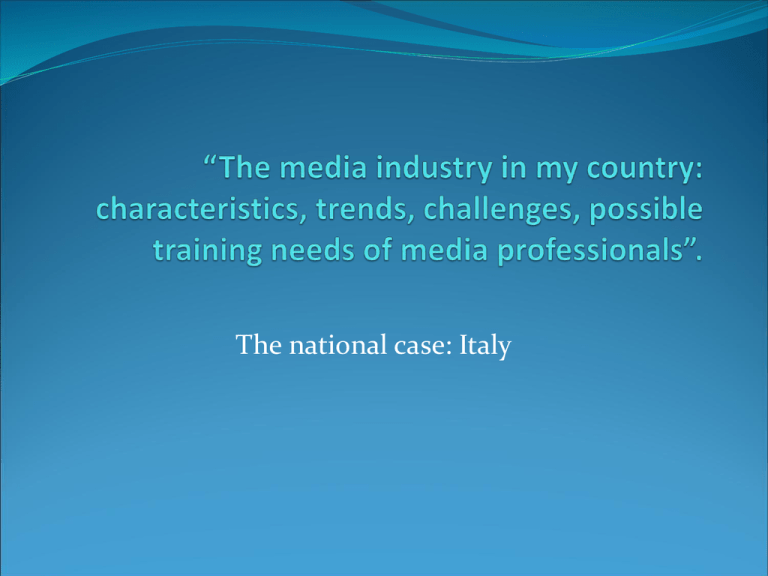
The national case: Italy Mapping Digital Media: Italy Digital terrestrial television was introduced in Italy with the adoption of the Digital Broadcasting Law in 2004. The switch-off of analog broadcasting started in 2009 and is based on the progressive “digitization” of regional areas. The deadline for the definitive switch-over from analog to digital broadcasting is set for 31 December 2012. The transition to digital terrestrial radio (digital audio broadcasting, or DAB) is taking place at a slower pace. Unlike television, it does not require analog switch-off . Leading Sources of News The national television news and traditional newspapers are the most used media sources by Italians to obtain news about politics, daily news, and relevant personal news. 80.9 percent of Italians use television news programs as their main source of information; radio news programs, used by 56.4 percent of the population; daily newspapers : 47.7 percent; periodical magazines: 46.5 percent; Televideo: 45 percent; web search engines: 41.4 percent; information websites: 29.5 percent; Facebook: 26.8 percent; online newspapers: 21.8 percent; “all news” television channels: 16.3 percent. Poor Infrastructures While more than 50% of italians in the age 14-29 gathers information from internet sources, Italy still lacks a reasonable amount of internet access for the population because of the absence of cable infrastructure. The country’s dependence on DSL results in one of Europe’s lowest broadband penetration rates (around 50%). It means Italy ranks 22nd between EU members and is the last of the G7 members. Print Media Traditional newspapers are the media sector most influenced by technological innovation and the global economic crisis. In Italy, as all over the world, there is animated debate on the crisis of newspapers. Leading newspaper groups were certainly hit hard by the financial crisis since 2008. Although these companies record an increase (sometimes remarkable) in users of their websites, overall newspaper sales have been in long-term decline, fuelling concerns over whether professional journalism is financially sustainable in the long term. Average sales of the five main quality daily newspapers, March 2010 Traditional newspapers are gaining significant traction in the internet environment. On average, the most visited online editions of major newspapers are: Repubblica.it, Corriere.it, Ilsole24ore.it, and Lastampa.it. The increasing consumption of these major newspapers online partly explains the slow decline in newspaper circulation, which began before their online expansion. It is worth nothing that in 2006, the fifth-highest ranking news website was Varesenews.it, an online paper of local information. What is referred to as local online information is one of the most important features of digital media with respect to news diversity. Television The television landscape, including news, is dominated by RAI, the public service broadcaster; Mediaset, the privately owned broadcasting giant; Sky Italia, News Corporation’s satellite pay-TV broadcaster. RAI RAI continues to attract a very high percentage of the national television audience along with its main commercial competitor, Mediaset. On average during 2010, RAI attracted 41.4 percent of the television audience, while Mediaset commanded a 39.4 percent share. This shared dominance of the national audience has been relatively stable over recent years, with RAI losing just 2 percent of its existing national audience share since 2005. The All-news Challenge The main problem for Rai at the moment is the complete lack of innovation. Sky is doing great with SkyTg24, the most watched allnews channel in Italy and Mediaset just started its own all-news channel – TgCom24 – which can be seen on tv, on the pc and in any smartphone or tablet. Rai instead still sticks with RaiNews, that receives low funds and gives low audiences in return . It’s unreasonable thinking about what could be done having over 1800 journalists. MEDIASET The RAI–Mediaset duopoly is a fundamental feature of the Italian television market, and results from the lack of adequate legislation regulating the competitive landscape. The duopoly, which had existed de facto since broadcasting was opened to the private sector in 1975, was legitimised in 1990 by a law which allowed a single entity to hold three national licenses at the same time. SKY ITALIA In July 2009, AGCOM announced that a third private operator, News Corporation’s satellite pay-TV broadcaster Sky Italia, had surpassed Mediaset in total revenues for 2008. 41 Sky Italia’s high revenues derive mainly from the annual subscription fees paid by a limited number of people, whereas the other two broadcasters derive most of their revenue from advertising. Breaking the Duopoly? In october 2011 Sky Italia announced they reached 5 million subscribers. It’s a never before seen goal for a satellite pay tv in Italy. In 2003, before Sky Italia, the number of subscribers was less than 2 millions in total. La7, the tv broadcasting owned by Telecom Italia, is rapidly growing, especially thanks to Tg La7, guided by italian journalism star Enrico Mentana, a former Mediaset figure. With Mentana Tg La 7 reached over 3 million viewers, battling with Rai moloch Tg1 and Mediaset’s Tg5, both with around 5 million viewers. User-Generated Content (UGC) Internet use in Italy has been marked by an increase in the use of blogs and by consistent growth of the most popular social networking websites, Facebook in particular. Since the early 200s, the Italian blogosphere has been characterized by its close attention to the world of information; indeed, analysts have defined it as an extension of the latter. The blogosphere, however, should not be considered a source of news, because as bloggers routinely update their blogs, they do not usually look for original news items. Instead, they reframe and comment upon news in the mainstream media agenda. Social Networks Italy’s social network world is ruled by one name: Facebook. There are more than 20 millions accounts for 60 million people. Numbers say that 93% of italian internet users have a Facebook account. Twitter is growing too, but at a slower rate (and later than in the rest of Europe) . At the end of 2011 more than 2 millions account have been created, with an average of 200 tweets per minute. Media Today The crucial point is: Italy does not have a tradition of strong independence of the news media, be they printed or electronic, public or commercial, from political influence. “Political parallelism” is a structural feature of relations between media and political systems Developments in the last five years have further confirmed that the Italian news media even in the digital era have to confront sustained pressures emanating from political leaders and parties. So what we have to do now is to remove this obstacle. On the one hand undoubtedly exist more channels, more news providers, more voices, but — given the constraints discussed in our report — they are overtaken by the endurance of the RAI–Mediaset duopoly, at least within the free-to-air television market. Media Tomorrow Accordingly, the scenario for the immediate future shows the presence of the “old” determinants of the current state of things, and at the same time the definitive signs of rapid technological change. The most dynamic changes are arguably occurring in mobile technology. Given the large diffusion of mobile telephony in Italy, it is reasonable to forecast a significant increase of technological and commercial investment in that direction. But the role of telecoms in the new digital landscape remains unclear: will they limit themselves largely to their traditional practice of providing networks or will they move further into the slippery field of content distribution? Telecom Italia has already stepped forward into digital television and the other companies might follow as well, should the media–politics complex change. Professional journalism is confronting a significant challenge from the web. The social media are going to be the main channels of information for ever-larger audiences, bypassing the mediation of traditional journalism. There will of course be concomitant new opportunities for the practice of online journalism. But the passage to a new world of news-making is characterized by hesitancy and reluctance to let go of the traditional print- and analog-centered thinking; this perpetuates the failure to monetize online news and thereby off set revenue decline in the print sector.
